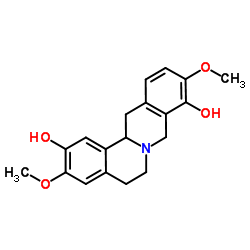6451-73-6
| Name | (S)-scoulerine |
|---|---|
| Synonyms |
2,9-DIOXY-3,10-DIMETHOXYBERBINE
(±)-Scoulerine 3,10-Dimethoxy-5,8,13,13a-tetrahydro-6H-isoquinolino[3,2-a]isoquinoline-2,9-diol 6H-Dibenzo(a,g)quinolizine-2,9-diol, 5,8,13,13a-tetrahydro-3,10-dimethoxy- 6H-Dibenzo[a,g]quinolizine-2,9-diol, 5,8,13,13a-tetrahydro-3,10-dimethoxy- Scoulerin Aequaline Alkaloid HF-1 l-scoulerine (RS)-Scoulerine scoulerine l-skoulerine |
| Description | Scoulerine ((-)-Scoulerine), an isoquinoline alkaloid, is a potent antimitotic compound. Scoulerine is also an inhibitor of BACE1 (ß-site amyloid precursor protein cleaving enzyme 1). Scoulerine inhibits proliferation, arrests cell cycle, and induces apoptosis in cancer cells[1]. |
|---|---|
| Related Catalog | |
| In Vitro | Scoulerine ((-)-Scoulerine) inhibits mini-panel of human leukemic cells, MOLT-4 (WT), Jurkat (TP53 mutated), Raji (TP53 mutated), HL-60 (TP53 null), U-937 (TP53 mutated), and HEL 92.1.7 (wild-type), with IC50s ranging from 2.7 µM to 6.5 µM[1]. Scoulerine (2.5-20 µM; 24 hours) decreases proliferation of Jurkat and MOLT-4 cells[1]. Scoulerine (2.5-20 µM; 24 hours) induces MOLT-4 and Jurkat cells apoptosis[1]. Scoulerine induces G2 or M cell cycle arrest[1]. Scoulerine (2.5-5 µM; 24 hours) shows an upregulation of p53 protein in p53 wild-type MOLT-4 cells[1]. Scoulerine (2.5-5 µM; 24-48 hours) activates caspase-3/7, -8 and -9 in a dose-dependent manner[1]. Scoulerine (5-10 µM; 24 hours) disrupts microtubule structure of A549 lung carcinoma cells[1] Cell Proliferation Assay[1] Cell Line: Jurkat and MOLT-4 cells Concentration: 2.5, 5, 10, 15 and 20 µM Incubation Time: 24 hours Result: Significantly reduced the viability and proliferation of Jurkat and MOLT-4 cells in a dose dependent manner. Apoptosis Analysis[1] Cell Line: MOLT-4 and Jurkat cells Concentration: 2.5, 5, 10, 15 and 20 µM Incubation Time: 24 hours Result: Induced MOLT-4 and Jurkat cells apoptosis. Cell Cycle Analysis[1] Cell Line: Jurkat and MOLT-4 leukemic cells Concentration: 2.5-20 µM Incubation Time: 16 hours Result: Induced cell cycle arrest at the G2/M transition. Western Blot Analysis[1] Cell Line: MOLT-4 cells Concentration: 2.5, 5 µM Incubation Time: 24 hours Result: Showed an upregulation of p53 protein in p53 wild-type MOLT-4 cells. |
| References |
| Density | 1.4±0.1 g/cm3 |
|---|---|
| Boiling Point | 503.3±50.0 °C at 760 mmHg |
| Melting Point | 192ºC |
| Molecular Formula | C19H21NO4 |
| Molecular Weight | 327.374 |
| Flash Point | 258.2±30.1 °C |
| Exact Mass | 327.147064 |
| PSA | 62.16000 |
| LogP | 2.16 |
| Vapour Pressure | 0.0±1.3 mmHg at 25°C |
| Index of Refraction | 1.680 |
CHEMICAL IDENTIFICATION
HEALTH HAZARD DATAACUTE TOXICITY DATA
|
| Hazard Codes | Xi |
|---|


